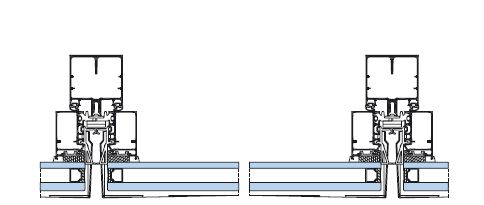- FORUM
- PROJECTS
- ABOUT US
- RESOURCES
- CONTACT US
- FORUM
- PROJECTS
- ABOUT US
- RESOURCES
- CONTACT US
Structural Glazing System
Types of structural glazing available.
- Unitized Structural Glazing System With sub frame and glass pasted ready to hang on brackets.
- Semi Unitized Structural Glazing System :curtain wall system is one in which the primary structural framing components are erected individually in the field.
- Stick Structural glazing system :Unitized system with out subframe glass directly pasted on frame.
- Curtain Wall Structural glazing system :Glass fixed to frame with pressure plate and cover plate.
Unitized Structural Glazing System
A “unitized” curtain wall system is one in which the framing members are pre assembled in factory, into units which are typically 4 ft wide and one story tall. Then, the vision glass and spandrel materials are installed into the units in the factory. All glazing gaskets and joinery sealants are factory installed; however, perimeter sealants would still be field installed. These assembled and pre-glazed units are then shipped to the jobsite for field erection. Vertical and horizontal mating joints can either be dry sealed with gaskets or wet-sealed with field-applied sealants. Making joints can be a male/female configuration.

Unitized systems handle these movements better when the glass is silicone glazed, and either system, when properly designed, can usually be made to work well for conventionally glazed applications. Wind loading is transmitted form the glass or infill material to the horizontal and vertical mullions. In semi-unitized systems, the vertical mullions can span two floors (twin-span) and provide greater structural efficiency than single-span mullions typically used in unitized systems. However, if the mullion expansion joint is near stool height (approximately 700mm above “zero moment” or continuous-span design, which is even more efficient than twin-span design, and can be utilized with either a semi unitized or unitized approach.
Semi Unitized Structural Glazing System
A “Semi unitized” curtain wall system is one in which the primary structural framing components are erected individually in the field like an erector set, typically with vertical mullions attached first to the floor slabs and the horizontals attached to the vertical mullions. Then, the vision glass and spandrel materials (typically glass, aluminium panel or stone) are factory glazed and installed into the assembled grid work. All joinery / perimeter sealants are field installed.

Stick Structural Glazing System
A “STICK TYPE” curtain wall system is one in which the primary structural framing components are erected individually in the field like an erector set, typically with vertical mullions attached first to the floor slabs and the horizontals attached to the vertical mullions. Then, the vision glass and spandrel materials (typically glass, aluminium panel or stone) are installed into the erected grid work. All joinery / perimeter sealants are field installed.
Curtain Wall Structural Glazing System
The curtain wall method of glazing allows glass to be used in large uninterrupted areas creating consistent attractive facades.

Forum Threads
Study Notes PDF
Study Notes for CURTAIN WALL & STRUCTURE GLAZING useful for student of architecture in Building Construction
CURTAIN WALL & STRUCTURE GLAZING.pdf
Register in Front Desk Architects & Planners Forum to download above PDF
Disclaimer
Information on this site is purely for education purpose. The materials used and displayed on the Sites, including text, photographs, graphics, illustrations and artwork, video, music and sound, and names, logos, IS Codes, are copyrighted items of respective owners. Front Desk is not responsible and liable for information shared above.